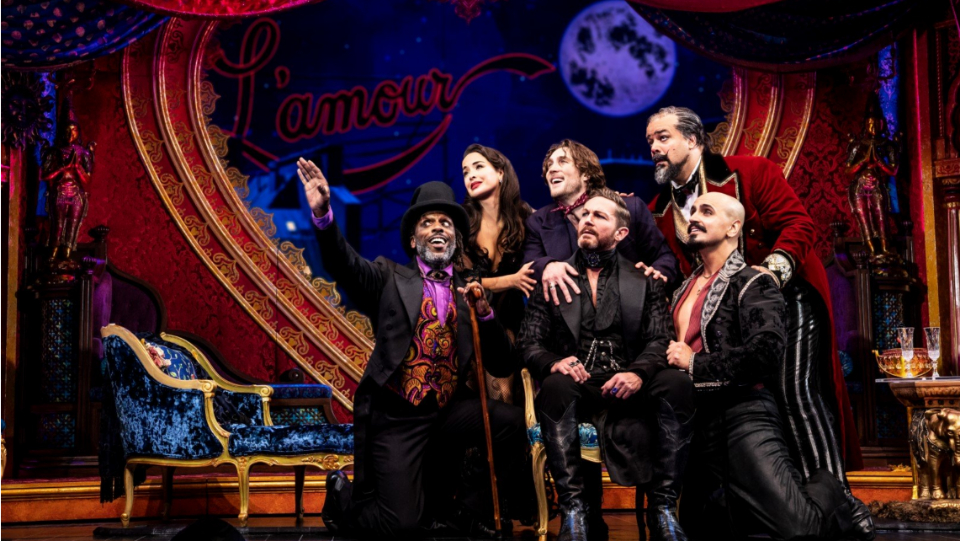‘Red Mill! The Musical’ stuns with dance, song and spectacle – People’s World
The cast of ‘Moulin Rouge! The Musical’ / Matthew Murphy
LOS ANGELES—As spring follows winter, it was inevitable that Baz Luhrmann’s iconic, over-the-top extravaganza in 2001 red Mill by 20th Century Fox, starring Nicole Kidman, Ewan McGregor, John Leguizamo, Jim Broadbent and Richard Roxburgh, would be transformed into an even more exuberant, rhythmic and dance-filled musical for live audiences. The film premiered at the 2001 Cannes Film Festival, and at the 74th Academy Awards it was nominated for eight Oscars and won two, not the most desirable (Best Art Direction for Set Decoration and Best Design of suits).
Red Mill! Musical comedy is the winner of ten 2021 Tony Awards, including Best Musical, two Drama League Awards, including Outstanding Production of a Musical, five Drama Desk Awards and ten Outer Critics Citations of Honor Circle Award, including New Broadway Musical. It opened at the Al Hirschfeld Theater in mid-2019 and reopened in September 2021 after Broadway was closed due to the pandemic. The show is still on Broadway and in London’s West End, and now a third company is touring nationally. In LA, he’s playing at the Hollywood Pantages Theater until September 4 – a good place for that, an enchanting 1920s Art Deco venue.

As anyone who has ever visited Paris knows, the Moulin Rouge nightclub still exists at the foot of the Montmartre hill and has been a popular tourist attraction emblematic of Parisian partying since 1889. evening at the Moulin Rouge (the “moulin rouge” with its iconic spinning windmill arms) is complete without a performance of the traditional long-legged cancan dance as part of its two-hour Féerie revue show with cabaret, stages music hall dance and surprise interspersed acts. From 1891, the artist Toulouse-Lautrec created posters promoting the establishment, which became the recognizable pictorial idiom not only of the club, but represented all of the metropolitan culture of the Belle Époque, before the First World War. .
Like in the movie, Red Mill! Musical comedy pays homage to over 160 years of music, from Jacques Offenbach, who reveled in the can-can era and composed his most famous musical numbers, to Lady Gaga, Britney Spears, Soft Cell, the Eurhythmics, White Stripes and countless other singers and songwriters. We are as likely to hear an excerpt from “Some Enchanted Evening” or “The Hills Are Alive” as a theme from Bizet’s opera Carmen. In fact, in the original film, and I believe it still is here, the main romantic ballad, “Come What May”, remains the only original song composed for the score. The musical features many songs from the film, as well as recent and commonly recognized hits released since the film premiered 20 years ago.
Broadway offered many “reviews” comprising either the songs of a particular composer (Fats Waller, for example, in Don’t misbehave), or of a particular era (the Second World War is popular), or on a specific subject (such as the musical Work), or the repertoire of a certain singing group like the Temptations (Ain’t too proud) or a genre such as boy bands (Plaid forever).
Red Mill! Musical comedy may have taken the principle of pastiche further than anything else so far. The entire score is a mash-up, a sample of hundreds of pop songs calculated to coax smiles and happy feelings from row upon row of theater patrons. Almost nothing lasts more than a few seconds. They start with “Do you want to sleep with meto set the mood. Aside from “Come What May”, the only song I remember featured in anything resembling its entirety is “Nature Boy”.
No need to wonder what these anachronistic and uprooted tunes have to do with end of century Paris (the action takes place in 1899), besides the fact that in all generations, and in all cultures, certain fundamental themes such as infatuation, obsession, love, jealousy, disappointment, commonly appear in music. They only exist here to be exploited commercially. I hope heavy royalties will be paid from this show! I suppose, despite that expense, it was the idea of something for everyone’s musical taste that commandeered the thought behind the show (and the film that preceded it, of course). Because even the score of a great Broadway composer could not come together in this wide range of eras, styles, orchestrations, rhythms, movements, memories, clues. Better to leave any thought of artistic integrity at the door.

However, a show is much more than its music. There is also the story, which in this case also has its problems of, let’s say, “appropriation”. The action takes place at the Moulin Rouge and in the surrounding localities. Many performers have talents other than dancing and singing; in a word, these flirtatious are also available for other services, including our leading lady Satine (Courtney Reed), who is still a great singer but is pursuing her career. The establishment goes bankrupt, so Harold Zidler, the owner (Austin Durant), features her in a brand new dramatic revue with music, which will be funded by the Duke of Monroth (David Harris) if Satine gives her full attention. time as his courtesan, though she is reminded, “You can’t always get what you want.”
An American composer, Christian (Conor Ryan) has just arrived in Paris and is recruited by two bohemian types, the writer – not an artist but borrowing his name – Toulouse-Lautrec (André Ward) and an Argentinian choreographer Santiago (Gabe Martínez ) to compose the score of the musical piece (“Bohemian Rhapsody”, very original, a piece in the piece, as in Hamlet) which they sell at the Moulin Rouge as his salvation. Christian and Satine fall in love, and their signature song is the aforementioned “Come What May”, but of course the Duke is a complication. And unbeknownst to either of them, she is dying of consumption, a polite word for tuberculosis, a disease typical of the urban poor. But hey, “All you need is love.”
Hmmm, Paris, artists, courtesans, consumption. This plot sounds familiar, doesn’t it? Yeah it is Bohemian and La Traviata—which, by the way, had original scores. Verdi’s opera La Traviatagame based The Lady of the Camellias by Alexandre Dumas fils, was quite radical for its time, setting itself in contemporary times and, rather shockingly to its early audiences, elevating the character of its protagonist, the beautiful Parisian courtesan Violetta, to a higher moral status. than the bourgeois parochial moralists who surrounded him. , and more, no doubt, than many in the opera public. For Verdi this was personal, as he himself was engaged in a relationship with a woman to whom he was not married, and they suffered great scorn from his smug peers. These two operas are still among the most performed in the world. A critic in Weekly entertainment concludes that “it is easy to believe that Red Mill! Musical comedy could last 50 years. The tragic dying lover, the mourning of the survivor (in short, the ancient myth of Orpheus), these are inexhaustible subjects.
Not that there isn’t suspicion radical bohemianism in musicals too. At one point, when the melodramatically evil Duke presses his demands on Satine, she retorts, “Nobody owns me.” And when he offers to save the Moulin Rouge from bankruptcy – on his own terms, of course – he is called a “bloodsucking corporate vampire”. “We are not just putting on a play, says the writer Lautrec, we are making a revolution. The word “proletarian” comes up more than once. These lines, small excavations at the height of society, obtain an appreciative response. There is also a bit of intergenerational faggoterie. As I say, something for everyone.
So what’s the appeal? It’s simply, stunning, glistening fabulous! In terms of production, it’s like fireworks for two and a half hours. Every element of the stage’s futuristic magic is brought to bear – an incredible array of shimmering lighting effects, a powerful and heart-pounding sound system I haven’t experienced since my disco days, explosions of silver confetti, snow, absinthe hallucinations, etc. all theatrical stops were dropped.
There is barely a moment when the scene is motionless. The set reshapes itself every few seconds. The cast is constantly on the move, and aside from the 11 named characters, there’s an 18-member dance ensemble and the choreography is out of this world (don’t be late to sit down after intermission or you’ll miss the number of highlights of the show). Do not think either that the dance is all gossip, all the other anachronistic genres are also represented, the Apache, the tango, the frug…. The sensuality suggested by the decor of the Moulin Rouge is highlighted, the women sail suggestively even as the public finds its place. Expect to see thousands of legs in the air before the final curtain, and if you stick around long enough for the final arcs, men in tutus!
The curmudgeon in me says, But there’s no time or open space for a theatergoer to go down in history with all those high-tech production values constantly in their path. The musical’s oft-repeated dedication to “Truth, Beauty, Freedom and Love” seems formulaic at best, like empty words addressed to no one in particular printed on the gold foil wrappers of expensive sweets.

Director of this mountain of sultry overload is Alex Timbers, working with book by John Logan, choreography by Sonya Tayeh and musical supervision, orchestrations and arrangements by Justin Levine. The design team includes Derek McLane (sets), Catherine Zuber (costumes), Justin Townsend (lighting), Peter Hylenski (sound), David Brian Brown (wig and hair design), Sarah Cimino (makeup design) and Matt Stine (music producer).
That said, to appropriate what some of our critical forefathers have said in the past, if this is the kind of thing you like, you’ll love it.
Red Mill! Musical comedy runs through September 4 at the Hollywood Pantages Theater, 6233 Hollywood Blvd., Los Angeles 90028, with performances Tuesday through Friday. at 8 p.m., Sat. at 2 p.m. and 8 p.m., and Sun. at 1 p.m. and 6:30 p.m. The duration is 2h45 with an intermission. Recommended for people aged 12 and over. Tickets are available at BroadwayInHollywood.com or Ticketmaster.com, by phone at (800) 982-2787, or in person at the theater box office. The national touring company is moving to the Segerstrom Center for the Arts in Costa Mesa, Calif. from November 9-27. For ticketing and other information, go to www.SCFTA.Org or call (714) 556-2787.



Comments are closed.